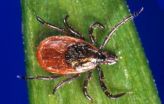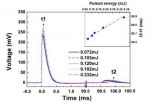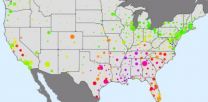(Press-News.org) Researchers at the National Eye Institute (NEI) have described the functions of a gene responsible for anchoring cilia – sensory hair-like extensions present on almost every cell of the body. They show in a mouse model that without the gene Cc2d2a, cilia throughout the body failed to grow, and the mice died during the embryonic stage. The finding adds to an expanding body of knowledge about ciliopathies, a class of genetic disorders that result from defects in the structure or function of cilia. NEI is part of the National Institutes of Health.
The findings are published in the online journal Nature Communications. Senior author Anand Swaroop, Ph.D., is chief of the NEI laboratory of Neurobiology-Neurodegeneration and Repair. Lead author Shobi Veleri, Ph.D., is a research fellow in the laboratory.
Cilia are responsible for cell communication and play a key role in the receptor cells of sensory systems. For example, they are essential for odor detection in the nose and light reception in the eye. Because cilia are such a key element of cells, defects in genes that are involved in cilia development or function can cause complicated syndromes involving multiple organs and tissues
Bardet-Biedl and Joubert syndromes are examples of ciliopathies with symptoms that include deafness, kidney disease, and degeneration of the retina. Meckel syndrome is a ciliopathy so dangerous babies with the genetic defect rarely make it to term.
On individual cells, cilia grow from the basal body, a circular dent on the outer membrane acting as a platform. Supporting structures called distal and subdistal appendages, which are like the flying buttresses supporting Notre Dame Cathedral, anchor the platform in the basal body, priming it for the growth of cilia. Once anchored, the structures that form the cilium begin to extend from the site. Inside are a variety of proteins essential to maintain the cilium. Cc2d2a is believed to make a structural protein needed for cilia growth, but its precise functions have been unclear.
Researchers developed a mouse lacking Cc2d2a to investigate the gene.
When they looked at the tissues of the mutant mice in very early stages of development, researchers found very few to no cilia, suggesting the gene plays a critical role at an early time. Looking closely at where the cilia should exist, the researchers saw that the supporting structures needed for cilia to grow were either completely missing or abnormal. In other experiments, the researchers found that the absence of Cc2d2a affected the activity of other genes and proteins involved in mouse nervous system development, including the key signaling protein, sonic hedgehog.
"This gene appears to play a key role in building structural support for the development of the cilia. Without this support, cilia are prevented from anchoring in the cell," said Dr. Swaroop. "It's like trying to build a house without a foundation. It's a big structural defect."
Studying the function and structure of cilia has become an active field of research that touches on many different organs and biological systems. More than 50 genes, including Cc2d2a have been discovered that, when defective, can lead to abnormal cilia development and ciliopathy in humans. By continuing to study how these genes work and interact, Dr. Swaroop said he hopes to gain further insight into not just how defects in genes related to cilia development in the retina cause vision problems, but the wider impact of these defects across body system and organs.
INFORMATION:
Reference:
Veleri, S et al. "Ciliopathy-associated gene Cc2d2a promotes assembly of subdistal appendages on the mother centriole during cilia biogenesis." Nature Communications, June 20, 2014. DOI: 10.1038/ncomms5207
NEI leads the federal government's research on the visual system and eye diseases. NEI supports basic and clinical science programs that result in the development of sight-saving treatments. For more information, visit http://www.nei.nih.gov.
About the National Institutes of Health (NIH): NIH, the nation's medical research agency, includes 27 Institutes and Centers and is a component of the U.S. Department of Health and Human Services. NIH is the primary federal agency conducting and supporting basic, clinical, and translational medical research, and is investigating the causes, treatments, and cures for both common and rare diseases. For more information about NIH and its programs, visit http://www.nih.gov.
NIH...Turning Discovery Into Health®
NIH study reveals gene critical to the early development of cilia
Cilia are key to a broad class of genetic disorders
2014-07-01
ELSE PRESS RELEASES FROM THIS DATE:
Smartphone app may revolutionize mental health treatment
2014-07-01
Mental illness accounts for 90 percent of all reported suicides and places the largest burden of any disease on social and economic infrastructures worldwide, according to the World Health Organization. There is a dire need for support services to assist clinicians in the evaluation and treatment of those suffering from mental illness.
New technology developed by researchers at Tel Aviv University is poised to transform the way in which patients with mental illnesses are monitored and treated by clinicians. Dr. Uri Nevo, research team engineer Keren Sela, and scientists ...
Muscle-powered bio-bots walk on command
2014-07-01
Engineers at the University of Illinois at Urbana-Champaign demonstrated a class of walking "bio-bots" powered by muscle cells and controlled with electrical pulses, giving researchers unprecedented command over their function. The group published its work in the online early edition of Proceedings of the National Academy of Science.
"Biological actuation driven by cells is a fundamental need for any kind of biological machine you want to build," said study leader Rashid Bashir, Abel Bliss Professor and head of bioengineering at the U. of I. "We're trying to integrate ...
Reducing deer populations may reduce risk of Lyme disease
2014-07-01
Since white-tailed deer serve as the primary host for the adult blacklegged tick (Ixodes scapularis) — the vector for Lyme disease — scientists have wondered whether reducing the number of deer in a given area would also mean fewer cases of Lyme disease. Now, after a 13-year study was conducted, researchers in Connecticut have found that reduced deer populations can indeed lead to a reduction in Lyme disease cases. The results of their study are published in the Journal of Medical Entomology .
The researchers surveyed 90% of all permanent residents in a Connecticut ...
Enlightening cancer cells
2014-07-01
This news release is available in German.
Harald Janovjak, Assistant Professor at IST Austria, together with Michael Grusch, Associate Professor at the Institute of Cancer Research of the Medical University of Vienna, "remote-controlled" the behaviour of cancer cells with light, as reported this week in EMBO Journal (DOI: 10.15252/embj.201387695). This work is the first application of the new field of optogenetics to cancer research.
To understand the dynamics of cellular signaling, researchers need to activate and inactivate membrane receptor proteins, which ...
A new method to detect infrared energy using a nanoporous ZnO/n-Si photodetector
2014-07-01
Experiments aimed at devising new types of photodetectors have been triggered by the increasing use of optoelectronic devices in personal electronics, cameras, medical equipment, computers and by the military. Professor Zhao Kun and co-researchers at the State Key Laboratory of Petroleum Resource and Prospecting, part of the China University of Petroleum in Beijing, have proposed a new type of infrared photodetector.
Photodetectors, which can convert photons to electrical signals, are used to observe and measure the wavelength or energy of light, including infrared light, ...
Drink walkers do it because their mates think it's okay: QUT study
2014-07-01
Friends may be the key to stopping their mates drink walking, a risky behaviour that kills on average two Australians every week, a QUT study has found.
Researcher Dr Ioni Lewis, from QUT's Centre for Accident Research & Road Safety - Queensland (CARRS-Q), said in a survey of young people aged 17 to 25, friends were the strongest influence on their intentions to drink walk.
"Drink walking, or walking while intoxicated in a public place, is linked to increased risk of injury and fatality," Dr Lewis said.
In a survey, published in Transportation Research, more than ...
EORTC presents European solution for effective cancer drug development
2014-07-01
Drug developers are facing the perfect storm. They are confronted with major patent expiries, increased payer scrutiny, changing priorities, shifting business models, increased risk averseness, increased clinical trial costs, not to mention issues concerning R&D productivity. There needs to be a better way to identify new candidate drugs. There needs to be a new drug development pathway that is compatible with research aimed at understanding the biology of a cancer and simultaneously able to support the design and conduct of subsequent confirmatory trials, but building ...
Unsuspected aspect of immune regulation revealed
2014-07-01
A discovery by Australian immunologists, uncovering an additional role for antibody-making 'B cells', is considered important enough by the American Association of Immunologists to rank it among the top 10% of articles in the latest issue of The Journal of Immunology, off the press today.
The finding by Senior Research Assistant Stacey Walters and Associate Professor Shane Grey, from Sydney's Garvan Institute of Medical Research, shows that B cells also participate in the development of 'regulatory T cells'.
T cells develop in the thymus gland, a soft triangular organ ...
New analysis of 'swine flu' pandemic conflicts with accepted views on how diseases spread
2014-07-01
The most detailed analysis to date of the spread of the H1N1 2009 pandemic influenza virus, known informally as 'swine flu', has found that short-range travel was likely the primary driver for the 2009 pandemic in the United States, in contrast with popularly accepted views on the way diseases spread.
The study, based on data gathered from health insurance claims made throughout 2009, found that international air travel, which was previously thought to be important in the pandemic, played only a minor role in its spread within the US.
A team of researchers from University ...
Cancer risk: Aspirin and smoking affect aging of genes
2014-07-01
The risk of developing cancer increases with age. Factors like smoking and regular aspirin use also affect the risk of cancer – although in the opposite sense. Researchers from the University of Basel were now able to show that aspirin use and smoking both influence aging processes of the female genome that are connected to colorectal cancer. The Journal of the National Cancer Institute has published their results.
Already in the 1990s, scientists discovered that regular use of aspirin over long periods of time decreases the cancer risk. Since then, numerous studies have ...
LAST 30 PRESS RELEASES:
Jeonbuk National University study shows positive parenting can protect adolescents against self-harm
Surface-engineered ZnO nanocrystals to tackle perfluoroalkyl substance contamination
This new understanding of T cell receptors may improve cancer immunotherapies
A new fossil face sheds light on early migrations of ancient human ancestor
A new immunotherapy approach could work for many types of cancer
A new way to diagnose deadly lung infections and save lives
40 percent of MRI signals do not correspond to actual brain activity
How brain-inspired algorithms could drive down AI energy costs
Gum disease may be linked to plaque buildup in arteries, higher risk of major CVD events
Contrails are a major driver of aviation’s climate impact
Structure of dopamine-releasing neurons relates to the type of circuits they form for smell-processing
Reducing social isolation protects the brain in later life
Keeping the heart healthy increases longevity even after cancer
Young adults commonly mix cannabis with nicotine and tobacco
Comprehensive review illuminates tau protein's dual nature in brain health, disease, and emerging psychiatric connections
Book prepares K-12 leaders for the next public health crisis
Storms in the Southern Ocean mitigates global warming
Seals on the move: Research reveals key data for offshore development and international ecology
Sports injuries sustained during your period might be more severe
World's first successful 2 Tbit/s free-space optical communication using small optical terminals mountable on satellites and HAPS
Can intimate relationships affect your heart? New study says ‘yes’
Scalable and healable gradient textiles for multi‑scenario radiative cooling via bicomponent blow spinning
Research shows informed traders never let a good climate crisis go to waste
Intelligent XGBoost framework enhances asphalt pavement skid resistance assessment
Dual-function biomaterials for postoperative osteosarcoma: Tumor suppression and bone regeneration
New framework reveals where transport emissions concentrate in Singapore
NTP-enhanced lattice oxygen activation in Ce-Co catalysts for low-temperature soot combustion
Synergistic interface engineering in Cu-Zn-Ce catalysts for efficient CO2 hydrogenation to methanol
COVID-19 leaves a lasting mark on the human brain
Scientists use ultrasound to soften and treat cancer tumors without damaging healthy tissue
[Press-News.org] NIH study reveals gene critical to the early development of ciliaCilia are key to a broad class of genetic disorders





